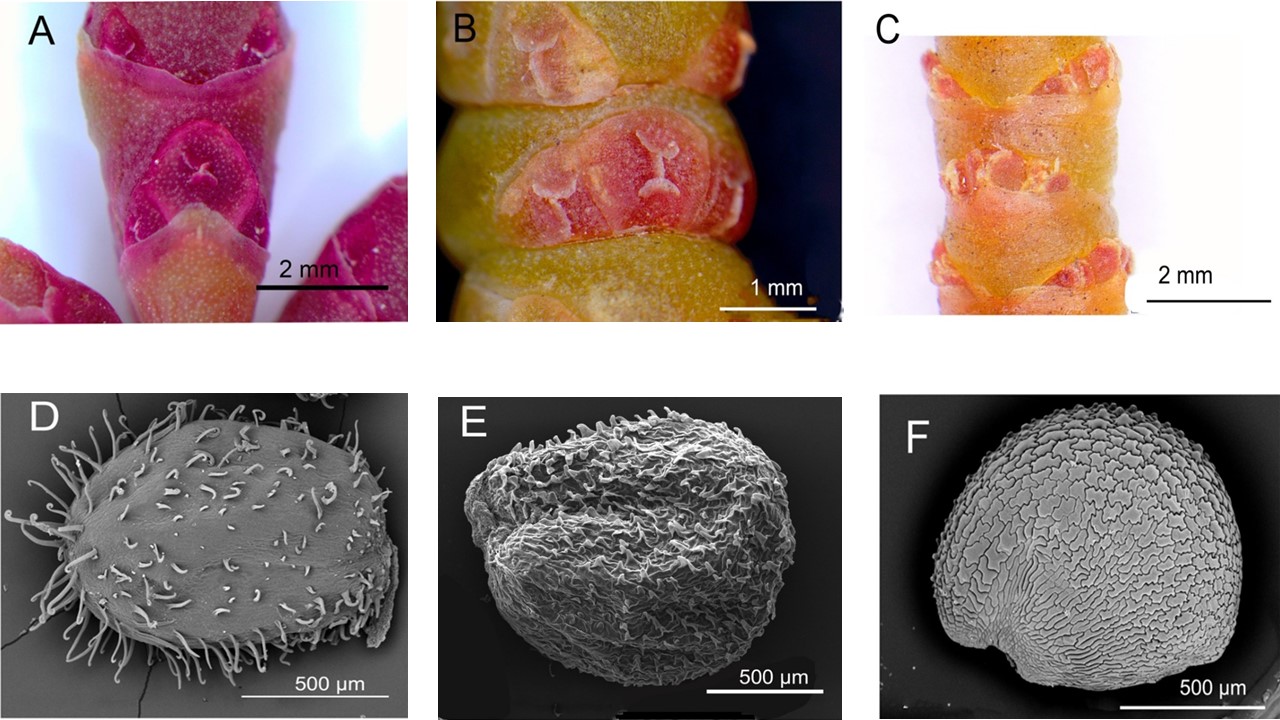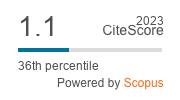Elemental uptake and antioxidant activity in edible Mediterranean halophytes from Tinto River
DOI:
https://doi.org/10.55779/nsb16211931Keywords:
antioxidants, compounds, halophytes, heavy metals, prolineAbstract
A complete survey is presented on elemental composition, selected amino acids and antioxidant capacity in edible halophytes from Spain. We include materials from the Iberian Peninsula: littoral-coastal Tinto River basin areas (SW Spain: Huelva province) and mainland territories (NW and central Spain: Zaragoza). The aim of this contribution is to characterize the relation between nutritional content compounds and their key role in antioxidant capacity in stress environments. Using analytical techniques such as ICP-MS, DPPH, FRAP and TBARS our results revealed the importance of different antioxidant responses in edible halophytes and their relations between elemental inorganic nutrients and stronger accumulation of some bioactive compounds like phenolic acids, flavonoids and amino acids. These molecules may be the key to the survival of these species in extreme saline environments located in Spain.
Metrics
References
Amils R, Fernández‐Remolar D (2020). Rio Tinto: An extreme acidic environmental model of astrobiological interest. Extremophiles as Astrobiological Models 21-44. http://dx.doi.org/10.1002/9781119593096.ch2
Barreira L, Resek E, Rodrigues MJ, Rocha MI, Pereira H, Bandarra N, Moreira Da Silva M, Varela J, Custódio L (2017). Halophytes: Gourmet food with nutritional health benefits?. Journal of Food Composition and Analysis 59:35-42. http://dx.doi.org/10.1016/j.jfca.2017.02.003
Barros L, Falcão S, Baptista P, Freire C, Vilas-Boas M, Ferreira IC (2008). Antioxidant activity of Agaricus sp. mushrooms by chemical, biochemical and electrochemical assays. Food Chemistry 111(1):61-66. https://doi.org/10.1016/j.foodchem.2008.03.033
Calone R, Mircea DM, González-Orenga S, Boscaiu M, Zuzunaga-Rosas J, Barbanti L, Vicente O (2023). Effect of recurrent salt and drought stress treatments on the endangered halophyte Limonium angustebracteatum Erben. Plants 12(1):191. https://doi.org/10.3390/plants12010191
Duan H, Tiika RJ, Tian F, Lu Y, Zhang Q, Hu Y, Cui G, Yang H (2023). Metabolomics analysis unveils important changes involved in the salt tolerance of Salicornia europaea. Frontiers in Plant Sciences 13:1097076. https://doi.org/10.3389/fpls.2022.1097076
El-Amier YA, Soufan W, Almutairi KF, Zaghloul N, Abd-Elgawad AM (2022). Proximate composition, bioactive compounds, and antioxidant potential of wild halophytes grown in coastal salt marsh habitats. Molecules 27(1):28. https://doi.org/10.3390/molecules27010028
Flowers TJ, Glenn EP, Volkov V (2019). Could vesicular transport of Na+ and Cl–be a feature of salt tolerance in halophytes?. Annals of Botany 123(1):1-18. https://doi.org/10.1093/aob/mcy164
Fuente V, Rufo L, Rodríguez N, Amils R, Zuluaga J (2010). Metal accumulation screening of the Río Tinto flora (Huelva, Spain). Biological Trace Element Research 134(3):318-341. https://doi.org/10.1007/s12011-009-8471-1
Fuente V, Rufo L, Rodríguez N, Sánchez-Mata D, Franco A, Amils R (2016). A study of Sarcocornia AJ Scott (Chenopodiaceae) from Western Mediterranean Europe. Plant Biosystems 150(2):343-356.
Fuente V, Rufo L, Sánchez-Gavilán I, Ramirez E, Rodríguez N, Amils R (2018). Plant tissues and embryos biominerals in Sarcocornia pruinosa, a halophyte from the Río Tinto salt marshes. Minerals 8(11):505. https://doi.org/10.3390/min8110505
García-Rodríguez P, MA F, Río CD, Romero-Bernal M, Najar AM, Cádiz-Gurrea ML, … Montaner J (2022). Diet supplementation with polyphenol-rich Salicornia ramosissima extracts protects against tissue damage in experimental models of cerebral ischemia. Nutrients 14(23):5077. https://doi.org/10.3390/nu14235077
Gargouri M, Magné C, Dauvergne X, Ksouri R, El Feki A, Metges MAG, Talarmin H (2013). Cyto-protective and antioxidant effects of the edible halophyte Sarcocornia perennis L.(swampfire) against lead-induced toxicity in renal cells. Ecotoxicology and Environmental Safety 95:44-51. https://doi.org/10.1016/j.ecoenv.2013.05.011
González-Orenga S, AL Hassan M, Llinares JV, Lisón P, López-Gresa MP, Verdeguer M, Vicente O, Boscaiu M (2019). Qualitative and quantitative differences in osmolytes accumulation and antioxidant activities in response to water deficit in four mediterranean Limonium species. Plants 8(11):506. https://doi.org/10.3390/plants8110506
Grigore MN, Toma C (2017). Definition and classification of halophytes. In: Anatomical Adaptations of Halophytes. Springer, Cham., pp 3-28.
Lima AR, Castaneda-Loaiza V, Salazar M, Nunes C, Quintas C, Gama F, Pestana M, Correia P, Santos T, Varela J, Barreira L (2020). Influence of cultivation salinity in the nutritional composition, antioxidant capacity and microbial quality of Salicornia ramosissima commercially produced in soilless systems. Food Chemistry 333:127525. https://doi.org/10.1016/j.foodchem.2020.127525
Limongelli F, Crupi P, Clodoveo ML, Corbo F, Muraglia M (2022). Overview of the polyphenols in Salicornia: From recovery to health-promoting effect. Molecules 27(22):7954. https://doi.org/10.3390/molecules27227954
Loconsole D, Cristiano G, De Lucia B (2019). Glassworts: from wild salt marsh species to sustainable edible crops. Agriculture 9(1):14. https://doi.org/10.3390/agriculture9010014
Lopes M, Silva AS, Séndon R, Barbosa-Pereira L, Cavaleiro C, Ramos F (2023). Towards the sustainable exploitation of salt-tolerant plants: nutritional characterisation, phenolics composition, and potential contaminants analysis of Salicornia ramosissima and Sarcocornia perennis alpini. Molecules 28(6):2726. https://doi.org/10.3390/molecules28062726
Nájar AM, Romero-Bernal M, Del Río C, Montaner J (2023). A review on polyphenols in Salicornia ramosissima with special emphasis on their beneficial effects on brain ischemia. Nutrients 15(3):793. https://doi.org/10.3390/nu15030793
Oliveira-Alves SC, Andrade F, Sousa J, Bento-Silva A, Duarte B, Caçador S, Salazar M, Mecha E, Serra AT, Bronze MR (2023). Soilless cultivated halophyte plants: volatile, nutritional, phytochemical, and biological differences. Antioxidants 12(6):1161. https://doi.org/10.3390/antiox12061161
Ramirez E, Chaâbene Z, Hernández-Apaolaza L, Rekik M, Elleuch A, Fuente V (2022). Seed priming to optimize germination in Arthrocnemum Moq. BMC Plant Biology 22(1):1-12. https://doi.org/10.1186/s12870-022-03893-2
Roberto VP, Surget G, Le lann K, Mira S, Tarasco M, Guérard F, Poupart M, Laize V, Stieger-Pouvreau V, Cancela ML (2021). Antioxidant, mineralogenic and osteogenic activities of Spartina alterniflora and Salicornia fragilis extracts rich in polyphenols. Frontiers in Nutrition 8(2021):555. https://doi.org/10.3389/fnut.2021.719438
Rodrigues MJ, Gangadhar KN, Vizetto-Duarte C, Wubshet SG, Nyberg NT, Barreira L, Varela J, Custodio L (2014). Maritime halophyte species from southern Portugal as sources of bioactive molecules. Marine Drugs 12(4):2228-2244. https://doi.org/10.3390/md12042228
Rozentsvet OA, Nesterov VN, Bogdanova ES (2017). Structural, physiological, and biochemical aspects of salinity tolerance of halophytes. Russian Journal of Plant Physiology 64:464-477. http://dx.doi.org/10.1134/S1021443717040112
Rufo L, Iglesias-López MT, Fuente V (2021). The endemic halophyte Sarcocornia carinata Fuente, Rufo & Sánchez-Mata (Chenopodiaceae) in relation to environmental variables: elemental composition and biominerals. Plant and Soil 460:189-209. https://link.springer.com/article/10.1007/s11104-020-04777-w
Sánchez-Gavilán I, Ramírez Chueca E, Fuente García V (2021). Bioactive compounds in Sarcocornia and Arthrocnemum, two wild halophilic genera from the Iberian Peninsula. Plants 10(10):2218. https://doi.org/10.3390%2Fplants10102218
Sánchez-Gavilán I, Ramírez E, Fuente V (2021). Bioactive compounds in Salicornia patula Duval-Jouve: A Mediterranean edible euhalophyte. Foods 10(2):410. https://doi.org/10.3390%2Ffoods10020410
Sánchez-Gavilán I, Rufo L, Rodríguez N, Fuente V (2021). On the elemental composition of the Mediterranean euhalophyte Salicornia patula Duval-Jouve (Chenopodiaceae) from saline habitats in Spain (Huelva, Toledo and Zamora). Environmental Science and Pollution Research 28:2719-2727. https://link.springer.com/article/10.1007/s11356-020-10663-w
Singh VK, Singh R, Rajput VD, Singh VK (2023). Halophytes for the sustainable remediation of heavy metal-contaminated sites: Recent developments and future perspectives. Chemosphere 313:137524. https://doi.org/10.1016/j.chemosphere.2022.137524
Urbano M, Tomaselli V, Bisignano V, Veronico G, Hammer K, Laghetti G (2017). Salicornia patula Duval- Jouve: from gathering of wild plants to some attempts of cultivation in Apulia region (southern Italy). Genetic Resources and Crop Evolution 64:1465-147. https://link.springer.com/article/10.1007/s10722-017-0521-5

Downloads
Published
How to Cite
Issue
Section
License
Copyright (c) 2024 Irene SÁNCHEZ-GAVILÁN, Vicenta de la FUENTE

This work is licensed under a Creative Commons Attribution 4.0 International License.
Papers published in Notulae Scientia Biologicae are Open-Access, distributed under the terms and conditions of the Creative Commons Attribution License.
© Articles by the authors; licensee SMTCT, Cluj-Napoca, Romania. The journal allows the author(s) to hold the copyright/to retain publishing rights without restriction.
License:
Open Access Journal - the journal offers free, immediate, and unrestricted access to peer-reviewed research and scholarly work, due SMTCT supports to increase the visibility, accessibility and reputation of the researchers, regardless of geography and their budgets. Users are allowed to read, download, copy, distribute, print, search, or link to the full texts of the articles, or use them for any other lawful purpose, without asking prior permission from the publisher or the author.













.png)















